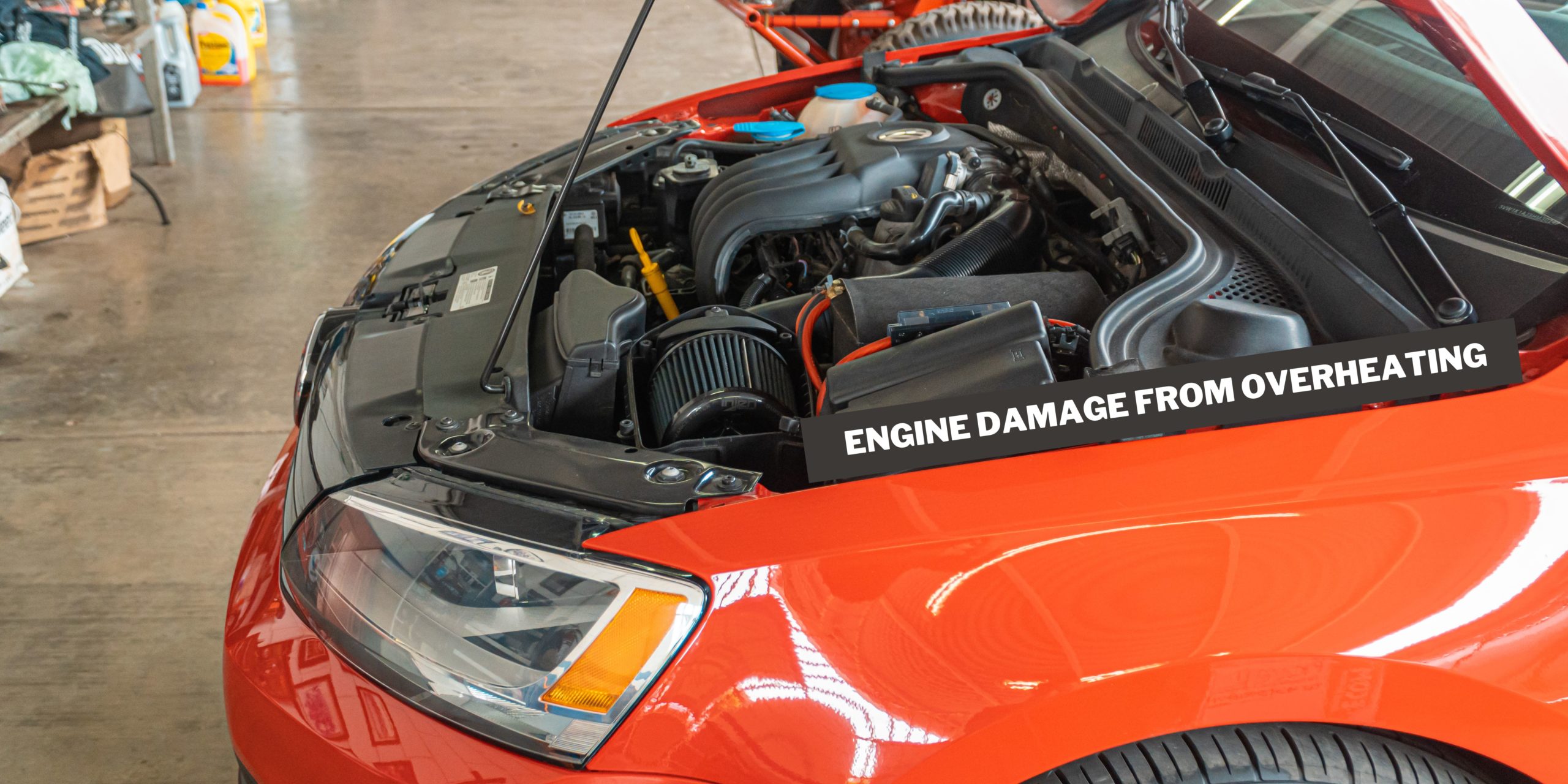Common symptoms of engine damage from overheating
The beating heart of your car is its engine. Should it overheat, it may cause serious engine issues and expensive repairs. A common problem which, when ignored, can result in serious damage is engine overheating.
The typical signs of engine damage due to overheating will be given in detail in this extensive text. By understanding these signs, you can take prompt action to prevent further harm to your engine and save money on repairs.
Elevated Temperature Gauge
Symptom: One of the most apparent symptoms of engine overheating is an elevated temperature gauge on your dashboard.
Detail: The temperature gauge that shows the engine’s operating temperature is a standard feature in contemporary automobiles. When your engine is running at the right temperature, the gauge should stay within a specific range. However, if it starts to climb into the “hot” zone, it’s a clear indication of a potential problem. Various problems, such as engine damage, might result from an overheated engine.
Steam or Smoke Under the Hood
Symptom: Severe engine overheating is evident when steam or smoke is seen coming from beneath the hood.
Detail: When your engine overheats, the coolant inside the engine and radiator can turn into steam, causing it to escape from various areas under the hood. This steam or smoke is often accompanied by a distinct, sweet smell, which is an indicator of a coolant leak. Ignoring this symptom can cause critical engine problems.
Reduced Power and Performance
Symptom: Engine overheating can result in a noticeable reduction in your vehicle’s power and overall performance.
Detail: When your engine temperature rises beyond a certain point, the performance is negatively affected. You may experience sluggish acceleration, reduced power when climbing hills, and an overall decrease in engine efficiency. This reduced performance is often the result of the engine’s computer system going into a “safe mode” to prevent further damage.
Unusual Engine Noises
Symptom: Overheating can cause your engine to produce unusual noises such as knocking, pinging, or hissing sounds.
Detail: As the engine temperature rises, various engine components can expand and contract rapidly. Due to engine stress, this may cause odd noises like knocking or pinging. You could occasionally hear a hissing noise that denotes a leakage of hot coolant. These noises should never be ignored, as they can be early warnings of engine damage.
Warning Lights on the Dashboard
Symptom: Modern vehicles come with warning lights that illuminate when there is an issue, including engine overheating.
Detail: Your vehicle’s onboard computer system continuously monitors the engine’s temperature and other vital parameters. When overheating occurs, warning lights, such as the coolant temperature warning light, can illuminate your dashboard. These lights are there to alert you to potential engine problems, and it’s crucial to pay attention to them and take immediate action.
Fluid Leaks
Symptom: Engine overheating can lead to fluid leaks, particularly coolant leaks, which are often noticeable underneath your vehicle.
Detail: You need coolant to keep your engine running at the right temperature. It’s possible for the cooling system to get excessively stressed as a result of the engine overheating and develop leaks. Check underneath your car for any puddles or stains, which are clear signs of a coolant leak. These leaks may cause additional engine issues if ignored.
Smell of Burning
Symptom: A noticeable burning smell, often accompanied by white or blue smoke from the exhaust, can be an indication of engine damage due to overheating.
Detail: When an engine overheats, various components can become extremely hot, leading to a distinct burning odor. The smell can be caused by overheated oil, coolant, or other engine fluids. White or blue smoke from the exhaust is also a sign of a severe issue and should not be ignored, as it indicates that engine coolant is entering the combustion chamber.
Loss of Engine Coolant
Symptom: A sudden decrease in engine coolant levels is a clear sign of a coolant leak, often caused by engine overheating.
Detail: The engine coolant is responsible for regulating the engine’s temperature. When overheating occurs, it can lead to a loss of coolant due to leaks. If you find yourself continuously replacing the coolant reservoir, it’s critical to get the problem resolved as soon as possible to prevent additional engine damage.
Visible Damage to Engine Components
Symptom: Severe engine overheating can lead to visible damage to engine components, such as cracked cylinder heads or engine blocks.
Detail: In extreme cases, the intense heat generated by engine overheating can cause physical damage to engine components. This damage may manifest as cracks in the cylinder head or engine block. Such damage is a severe issue that requires immediate attention and extensive repairs to prevent further engine problems.
Engine Stalling
Symptom: Engine overheating can result in engine stalling, causing your vehicle to come to a sudden stop.
Detail: The excessive heat generated during engine overheating can disrupt the engine’s normal operation. This may result in engine stalling, which may be quite hazardous, particularly if it happens while driving. Engine stalling should be treated as a severe symptom of engine damage, and the vehicle should not be driven until the issue is resolved.
Also read, common problems after engine replacement
Preventing Engine Damage from Overheating
Now that you’re familiar with the common symptoms of engine damage from overheating, it’s crucial to understand how to prevent these issues from occurring in the first place. To maintain your engine operating at its best, follow these recommendations:
Regular Maintenance
The key to avoiding engine issues and overheating is routine maintenance. It’s crucial to stick to the maintenance plan suggested for your car. This schedule typically includes routine checks of the cooling system, coolant levels, and overall engine health.
Check Coolant Levels
Coolant is the lifeblood of your vehicle’s cooling system. Check the amount of your coolant frequently, and top it off if required. Overheating is more likely when coolant levels are low. Additionally, ensure that the coolant mixture is at the correct ratio, as it plays a critical role in providing efficient cooling.
Inspect the Cooling System
The cooling system is responsible for maintaining your engine’s temperature within the safe operating range. Have the entire cooling system, including the radiator, hoses, and thermostat, inspected regularly. Overheating may be avoided with a properly maintained cooling system. Make sure there are no leaks or obstructions that might prevent coolant from flowing.
Address Leaks Promptly
Do something about any fluid leaks under your car promptly, especially any coolant leaks. Low coolant levels brought on by leaks raise the chance of overheating. They may corrode and harm the engine and other parts over time. Regularly check for puddles or stains beneath your vehicle and seek professional assistance if you detect any leaks.
Keep an Eye on the Temperature Gauge
A useful tool for preventing overheating in your car is the temperature gauge on the dashboard. Pay close attention to it while driving. If you notice the gauge rising into the “hot” zone, it’s a clear warning sign of potential overheating.
It’s critical to stop at an appropriate location in such circumstances and turn off the engine as soon as possible. Further damage can be avoided by letting the engine cool.
Also read: review on sbt japan used cars
Conclusion
In conclusion, understanding the symptoms of engine damage resulting from overheating is crucial for the longevity of your vehicle and your wallet. You may avoid expensive engine repairs and make sure your car operates smoothly for years to come by noticing these symptoms early and taking preventative action.




